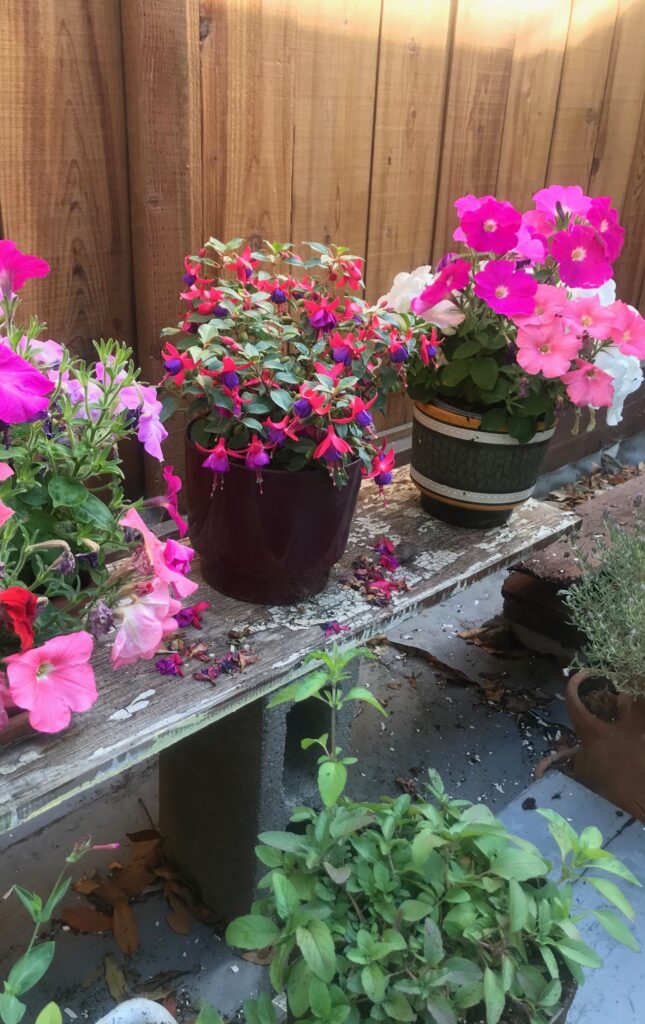Hardy Fuchsia is Not Toxic to Cats or Dogs
According to the ASPCA, fuchsia is not toxic to dogs, cats or other pets or wildlife, in fact it is safe for cats and dogs. So you know, we check the flowers we feature on our site with the ASPCA and do extensive internet research for both the common and scientific name just to be super pet safe. If we cannot find direct reference, we check up to genus and so on until we can confirm whether a plant is toxic or non toxic to both cats and dogs. If we are not sure, or get contradictory information, we do not include it. Many of the plants featured we have grown successfully in our own pet safe garden in Northern California. You can see many of garden stars in photos from Lovie’s Pet Safe Garden.
Physical Attributes
Fuchsias have delicate, pendulous flowers with four sepals and four petals in shades of red, pink, purple, white, or bi-colors. The flowers dangle from slender stems and can be single or double blooms. Fuchsias are shrubs or trailing vines with opposite leaves that can be green, red, or variegated.[1]
General Care Tips and Pointers
Plant fuchsias in partial shade and well-draining soil amended with compost or peat moss. Water regularly, keeping soil moist but not saturated. Feed every 2-4 weeks with a balanced liquid fertilizer. Pinch back tips to encourage bushier growth. Protect from hot afternoon sun and strong winds. Hardy fuchsias can overwinter in zones 6-10 with mulch.[1][3]
Fun Facts/Trivia
Fuchsias are named after the 16th century German botanist Leonhart Fuchs. There are over 100 species, mostly native to Central and South America. The first fuchsia was discovered in the Caribbean in 1696. Hummingbirds are attracted to the dangling flowers. Some varieties are edible with a slightly acidic, peppery flavor.[1]
Citations:
[1] https://www.thespruce.com/flowers-5092668
[2] https://chartopia.d12dev.com/chart/28718/
[3] https://www.picturethisai.com/care/Fuchsia_magellanica.html
[4] https://www.uaex.uada.edu/publications/pdf/FSA-6118.pdf
[5] https://darceyflowers.ae/blog/the-benefits-of-having-indoor-plants/

| Consideration | Details |
|---|---|
| Container Friendly | Yes, fuchsias are well-suited for containers and hanging baskets.[1][2][3][4] |
| Indoor/Outdoor | Both – can be grown outdoors in mild climates or as indoor houseplants.[1][2][4] |
| Sun/Shade | Partial shade to dappled sunlight. Protect from hot afternoon sun.[1][2][3][4] |
| Perennial/Annual | Perennial in zones 8-10, grown as an annual in colder zones.[1][3][4] |
| Flowering | Showy, pendulous flowers in shades of red, pink, purple, white from late spring to fall.[1][2][3][4] |
| Drought Tolerant | No, fuchsias require consistently moist soil.[2][4] |
| Pollinator Magnet | Yes, flowers attract hummingbirds, bees and butterflies.[3] |
| Beginner Friendly | Yes, relatively easy to care for with proper conditions.[1][2][4] |
| Good Ground Cover | No, upright or trailing shrub habits.[3] |
| Good Privacy Screen | No, heights typically only 1-3 feet tall. |
| Invasive/Spreader | No, not considered invasive.[1][2][3][4] |
| Dog & Cat Durable | Fairly rugged as a small, flowering shrub. |
| Rodent Repellent | Unknown |
| Deer Resistant | Unknown |
| Ideal States | Cool, humid coastal regions like the Pacific Northwest are ideal for fuchsias.[1][5] |
Citations:
[1] https://www.gardenia.net/plants/genera/fuchsia
[2] https://www.almanac.com/plant/fuchsias
[3] https://plants.ces.ncsu.edu/plants/fuchsia-magellanica/
[4] https://hgic.clemson.edu/factsheet/fuchsia/
[5] https://extension.psu.edu/fuchsias-then-and-now





